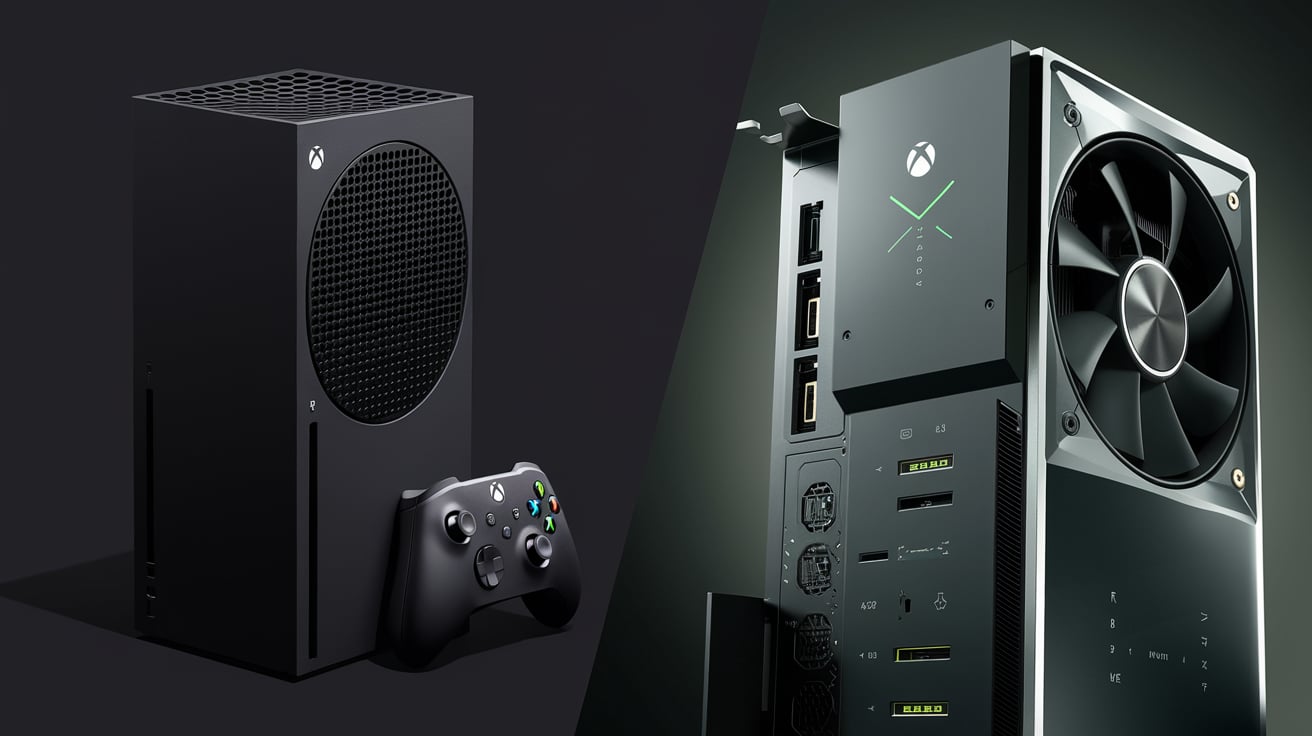Xbox Series X GPU: Its Edge Features RDNA 2
The Xbox Series X is a gaming powerhouse driven by its custom-designed graphics processing unit (GPU). Based on the Radeon 6800 architecture, the GPU is slightly modified with some compute units (CUs) disabled. This places the Series X GPU in between the performance of the Radeon 6700 XT and the Radeon 6800 discrete card.
While not an exact match, benchmark results show that the performance of the Series X is most likely to rival that of the NVIDIA RTX 3060 Ti or AMD RX 6700 XT, making it a solid choice for gamers.
From a hardware standpoint, the Series X packs impressive gaming performance similar to some high-end desktop GPUs. Even with the CUs disabled, the Series X GPU still delivers strong gaming benchmarks, indicating that it’s competitive with mid-range Radeon and NVIDIA graphics cards.
The performance metrics of the Series X are noteworthy, and while it’s not identical to the high-end desktop GPUs, it provides excellent gaming performance for a console.

The Series X GPU strikes a balance between the Radeon 6800 and RX 6700 XT, offering hardware-based performance that holds up well in comparison to discrete cards found in gaming PCs. Although it may not be an exact equivalent to these graphics cards, the Series X is still a powerful option for console gamers. Whether comparing benchmark results or gaming performance, the Series X GPU provides a solid experience that competes closely with some of the best in the desktop world.
Direct Comparisons Are Challenging
When it comes to the Xbox Series X GPU, directly comparing it to a PC graphics card is not straightforward due to several key factors.
- Optimization for console games is specifically tailored to the hardware, unlike PC games which need to support a wide range of components.
- Architectural differences between GPUs used in consoles and PCs make simple comparisons less reliable.
- Different architectures in consoles and PCs lead to varying levels of performance.
- Consoles often have a fixed hardware setup, whereas PCs can be upgraded and customized.
- Making an accurate comparison requires more than just looking at the GPU specs; it’s about how the whole system works together.
How the Xbox Series X Stacks Up
Rather than searching for a single equivalent PC card, it’s more useful to consider the performance ranges of the Xbox Series X GPU.
- Closest comparisons to the Series X GPU are the NVIDIA RTX 3060 Ti and the AMD RX 6700 XT.
- The Xbox Series X delivers impressive raw power, providing up to 12 teraflops of graphical processing capability.
- With its teraflops of graphical processing power, the Series X offers a strong performance benchmark.
- Instead of just comparing to one GPU, think of it as falling within a range of options.
- The Series X performs similarly to high-end NVIDIA and AMD graphics cards.
Also Read: 35+ Free PSN Codes: A Gamer’s And Rewards
Clarifying the GPU Comparison
When comparing a console’s GPU to a PC graphics card, it can be tricky due to their different designs and optimizations for various purposes. The Xbox Series X GPU uses AMD’s RDNA 2 architecture, which is also found in the Radeon 6800, but it’s a custom design specifically created for the console. This makes direct comparison somewhat challenging, as the Series X GPU is tailored to meet the needs of a gaming console rather than a general-purpose desktop GPU.

From a performance standpoint, benchmark results suggest that the Series X GPU performs more like an NVIDIA RTX 3060 Ti or an AMD RX 6700 XT than other cards. It’s a powerful option that is capable of handling demanding games at high resolutions and frame rates, providing impressive gaming performance. The benchmark results demonstrate that the Series X can deliver solid performance metrics, comparable to these desktop graphics cards.
The Series X GPU is designed for gaming performance and can run the latest titles smoothly, with the ability to process high-quality graphics at optimal settings. Its custom design, based on RDNA 2, makes it a unique contender in the console world, rivaling the performance of mid-range NVIDIA and AMD graphics cards. While the Series X GPU isn’t a one-to-one equivalent of any specific desktop GPU, its performance and ability to handle demanding games put it on par with some of the best graphics hardware available today.
Factors Beyond Pure Specs
Although the GPU is essential for gaming performance, other hardware components and software also significantly contribute to the overall experience.
| Factor | How It Impacts Performance |
| CPU | A faster CPU helps prevent bottlenecks and ensures smooth gameplay |
| Storage Speed | Fast storage solutions load games and assets quicker |
| Game Optimization | Well-optimized games run better on the same hardware |
Exclusive Features and Technologies: Beyond the Basics
The Xbox Series X comes with exclusive features designed to enhance its graphics performance.
- DirectStorage technology allows the console to load game assets directly from its internal SSD, leading to shorter loading screens and smoother gameplay.
- Features like Variable Refresh Rate (VRR) and Auto Low Latency Mode (ALLM) work with compatible TVs to improve the gaming experience by reducing input lag and screen tearing.
- VRR synchronizes the TV’s refresh rate with the game’s frame rate for smoother visuals.
- ALLM optimizes the TV settings for gaming with minimal delay, ensuring a more responsive gameplay experience.
- These technologies together create a seamless experience that enhances overall gaming performance on the Series X.
A Look at the Competition: PS5 vs. Xbox Series X
When comparing the Xbox Series X and PlayStation 5, both consoles offer powerful GPUs based on the RDNA 2 architecture. Each has its own strengths, but it’s hard to say that one has a clear edge over the other. The graphics power is similar on both systems, with each delivering amazing graphics and excellent gaming performance. It really comes down to personal preferences and what kind of games you want to play, as both systems offer unique experiences.

In terms of performance differences, the PlayStation 5 and Xbox Series X provide impressive gaming capabilities, but they each have different strengths when it comes to handling certain types of games. Some may prefer the PlayStation’s exclusive titles, while others may lean towards the Xbox Series X for its backward compatibility and overall performance. Ultimately, your console preference will depend on which games you enjoy most, but both consoles are powerful and offer a strong gaming experience.
Table: Key Xbox Series X GPU Specs
| Feature | Specification |
| Architecture | Custom RDNA 2 |
| Compute Units | 52 |
| Processing Power | Up to 12 teraflops |
| Memory | 16GB GDDR6 (10GB for graphics, 6GB for system) |
| Storage | 1TB Custom NVMe SSD |
| Clock Speed | 1.825 GHz (peak) |
Xbox Series X GPU Overview
The Xbox Series X boasts an advanced GPU that powers its impressive graphical performance. This custom-built hardware from Microsoft is at the heart of the console, providing top-tier gaming capabilities. The GPU is designed to deliver cutting-edge performance, allowing the console to handle graphical power at high resolutions with ease.
When you look at how the Xbox Series X compares to PC graphics cards, it’s clear that its performance is on par with some of the best available. The innovation behind the GPU gives the Xbox a unique edge in the gaming world, offering pow erful graphics and seamless gameplay. It’s a true competitor to PC gaming hardware, with performance that makes it a worthy choice for any gamer.
RDNA 2 Architecture
The Xbox Series X GPU is powered by the cutting-edge RDNA 2 architecture, a product of AMD’s engineering. This architecture brings significant enhancements over its predecessors, including improved power efficiency and higher performance. The 7nm process fabrication ensures that the GPU performs optimally, handling even the most demanding tasks.
One of the standout features of the RDNA 2 architecture is its support for ray tracing, which allows for realistic lighting and shadows in games. This adds a level of visual fidelity that pushes the gaming experience to new heights. With these innovations, the Xbox Series X GPU offers powerful performance and is a key factor in the console’s success.
Graphics Performance and Capabilities
The Xbox Series X GPU is designed with an impressive 52 compute units, offering a capacity to handle up to 12 teraflops of processing power. This setup allows the console to deliver exceptional high-fidelity 4K resolution gaming with smooth frame rates. The power behind this system ensures that players can enjoy visually stunning games at high performance.
In addition to its graphical capabilities, Microsoft’s machine is equipped with a generous 16GB of GDDR6 memory, ensuring that games not only look great but also run seamlessly. This combination of graphics performance and ample memory gives the Xbox Series X the ability to handle even the most demanding gaming experiences with ease.
Comparative Analysis With PC GPUs
When comparing the Xbox Series X GPU to PC graphics cards, it’s similar to top-tier GPUs like the NVIDIA GeForce RTX 3060 Ti or the AMD Radeon RX 6700 XT. These cards serve as a good baseline for evaluating performance and capabilities, as they offer similar features, including support for ray tracing and the ability to handle 4K gaming.

Both the Xbox Series X GPU and these PC graphics cards can deliver high-quality gaming experiences with ray-tracing capabilities, making them comparable in terms of graphical performance. However, the specific hardware optimizations for consoles and PCs create different user experiences despite the similarities in features.
Key Technical Specifications
When comparing a graphics processing unit (GPU) to the Xbox Series X console’s built-in capabilities, it’s important to assess key aspects such as memory capacity and processing power. These two factors play a significant role in determining the overall performance of the console.
The memory capacity and processing power of the Xbox Series X GPU ensure that it can handle demanding gaming tasks with ease, offering a smooth and high-quality experience. Evaluating these specifications allows for a better understanding of how the Xbox Series X stacks up against other gaming hardware.
Memory and Storage
The Xbox Series X is equipped with a custom GPU that utilizes GDDR6 memory, which is crucial for high-speed data processing in gaming scenarios. This GDDR6 RAM offers a generous 16 GB, with 10GB dedicated to fast graphics rendering and 6GB reserved for less intensive tasks, ensuring smooth gameplay.
In terms of storage, the Xbox Series X includes a 1TB custom NVMe SSD, enhancing game load times and improving console responsiveness. This combination of memory and storage ensures that the console can handle demanding games while providing a seamless and responsive gaming experience.
Clock Speed and Power Consumption
The GPU clock speed is essential for ensuring smooth gaming performance. The Xbox Series X achieves a peak of 1.825 GHz, which, when combined with the rest of the console’s architecture, allows it to reach up to 12 teraflops of processing power. This high clock speed plays a crucial role in delivering high-quality gaming experiences.
In terms of power consumption, thermal design power (TDP) is an important factor, though specific TDP figures for the console’s GPU are not publicized. The focus on efficiency ensures that the Xbox Series X runs optimally, balancing power consumption and performance without excessive energy use.
Gaming Ecosystem and Experience
The Xbox Series X acts as a bridge between console and PC gaming, merging the best aspects of both worlds. By integrating powerful hardware with software enhancements, it creates a seamless gaming ecosystem that elevates the overall experience.

Moreover, the gaming library on the Xbox Series X is carefully curated to offer a top-notch gaming experience. This combination of hardware, software, and exclusive content provides an exceptional platform for gamers looking for the ultimate gaming setup.
Game Compatibility and Frame Rates
The Xbox Series X offers robust game compatibility, ensuring that a wide range of Xbox One titles work seamlessly on the console. In addition to backward compatibility, many of these games receive performance enhancements, running at higher frame rates and resolutions for a better experience.
Gamers can expect smooth performance, with many titles reaching up to 120 frames per second (fps), especially when using a 4K display. This focus on performance ensures a fluid and immersive gaming experience, providing gamers with top-tier visuals and responsiveness.
Exclusive Features and Technologies
The Xbox Series X ecosystem is enhanced by exclusive features such as hardware-accelerated DirectX Raytracing, which ensures realistic lighting and reflections in games. This technology brings a level of visual fidelity that significantly improves the overall gaming experience.
Additionally, Variable Rate Shading (VRS) helps games run more efficiently by optimizing performance across different in-game objects and areas, leading to higher performance rates. With DirectX 12 Ultimate, developers can push the limits of real-time rendering to produce incredible visuals.
Comparison with Console Counterparts
When comparing the Xbox Series X to its console counterparts, such as the PlayStation 5, it becomes evident that the custom RDNA 2 architecture sets the Series X apart. This hardware enables features like faster load times and the ability to suspend and resume multiple games seamlessly, enhancing the gaming experience.
In terms of AI, the integration of machine learning helps upscale graphics, improving overall visual fidelity. This advancement allows the Xbox Series X to maintain an edge in the highly competitive console gaming landscape, delivering superior performance and gaming experiences.
FAQ’s
What is the Xbox Series X GPU equivalent to in PC graphics cards?
The Xbox Series X GPU is most closely equivalent to a NVIDIA RTX 3060 Ti or an AMD RX 6700 XT. It delivers similar gaming performance, supporting 4K resolution and ray tracing capabilities, though it’s a custom design tailored for the console.
How does the Xbox Series X GPU compare to the PlayStation 5’s GPU?
Both the Xbox Series X and PlayStation 5 feature powerful custom GPUs built on AMD’s RDNA 2 architecture. However, they have unique strengths, with the Xbox Series X offering a slightly more powerful GPU that can provide smoother performance at higher resolutions in certain games.
What are the key features of the Xbox Series X GPU?
The Xbox Series X GPU has 12 teraflops of processing power, built on a custom RDNA 2 architecture, and is capable of ray tracing and 4K gaming. It also features Variable Rate Shading (VRS) and DirectStorage, improving both performance and visual quality.
Can the Xbox Series X GPU handle 4K gaming at 120 FPS?
Yes, the Xbox Series X GPU is optimized for 4K gaming and can deliver up to 120 frames per second (FPS) in supported titles. This makes it capable of smooth, high-fidelity gameplay at 4K resolution, especially with a compatible display.
What makes the Xbox Series X GPU more efficient compared to others?
The Xbox Series X GPU benefits from advanced features like hardware-accelerated DirectX Raytracing, which enables realistic lighting and reflections. Additionally, it uses a high-performance custom design that balances power with energy efficiency, ensuring optimal performance without excessive power consumption.




Post Comment